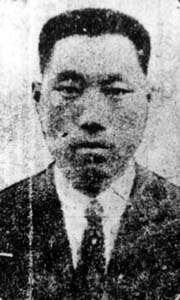Na Seok-ju
Na Seok-ju (Korean: 나석주, also romanized as Na Sok-Chu) (1892-1926) was a Korean nationalist made famous for his attack on the Oriental Development Company, an organization set up by Imperial Japan as part of its imperial expansion and development of its colonies.[1] Korea had been declared a Japanese protectorate in 1905 and annexed in 1910.
Na Seok-ju | |
|---|---|
 | |
| Born | 1892 |
| Died | December 28, 1926 |
| Cause of death | Suicide, gun wounds |
| Nationality | Korean (annexed by Japan in 1910) |
| Known for | Movement Activist |
| Awards | The Presidential Medal in the Order of Merit for National Foundation |
Life
Na Seok-ju originally grew up as a farmer in Chaeryong County, Hwanghae province of Korea.[2] As he got older, he moved "to Manchuria to receive military training for 4 years."[3] After having completed training, Seok-ju returned to his hometown and ran a store in town. While running the store, Seok-ju was also involved in underground political movements against Japanese colonial rule of Korea. During the March 1st Movement Seok-ju helped to organize local protest efforts and the funding of militant groups.[3]
Later, Seok-ju was responsible for killing multiple Japanese people of authority and a Korean man that was deemed to be a conspirator with the Japanese colonial rulers of Korea.[3] Because of this, Seok-ju had to flee to Shanghai, China, on September 22, 1920.[3] While in China, Seok-ju was a bodyguard for the Provisional Government of Korea.[3] The provisional government was formed in reaction to Japanese suppression of the March 1st Movement.[4] While in China, Seok-ju went to Tianjin to meet with Kim Chang-suk, and was asked by Kim to destroy the Oriental Development Company, Choson Bank, and Industrial Bank of Japan buildings back in Korea.[3] After carrying out the attack on December 28, Seok-ju shot himself three times, leading to his death later that evening.[3]
Attack
On December 26, Seok-ju worked his way south from Manchuria towards Seoul. After having used disguises to get across the border and through different checkpoints, on the 28th Seok-ju was ready to attack. He first went to the Industrial Bank and threw a grenade near the loan department. From there, Seok-ju made his way to the Oriental Development Building and proceeded to shoot Japanese office workers in the building. After entering and going up the stairs, Seok-ju tried to use another grenade to kill some higher level employees, but was unable due to the grenade being faulty. Leaving the building, Seok-ju attempted to escape, killing a Japanese police officer in his escape. As more officers closed in on his position, Seok-ju shot himself three times in the chest, and died later that day at the hospital he had been taken to by the police officers chasing him for treatment.[3]
Commemoration
While some would label Seok-ju as a terrorist for having attacked non-military targets, because of his motives to help free colonial Korea from its invaders, Seok-ju was given posthumous honors and acknowledgment as a nationalist hero.[5] On his statue, it reads "Na Sok-Chu (1892-1926) is beloved by the people of Korea for his heroic struggle to regain the sovereignty and economic independence of Korea, forcibly taken by the Japanese colonialists. On December 28, 1926, Na Sok-Chu, throwing grenades and firing a pistol, staged a single-handed attack on the offices of the Oriental Development Company, a notorious Japanese agency instrumental in the economic aggression against Korea."[6]
References
- Gragert, Edwin H. Landownership Under Colonial Rule: Korea's Japanese Experience, 1900-1935. N.p.: University of Hawaii Press, 1994. Print.
- Kim, Jinwung. A History of Korea: From "Land of the Morning Calm" to States in Conflict. N.p.: Indiana University Press, 2012. 344. Print.
- "Movement Activist." Independence Hall. The Independence Hall of Korea, n.d. Web. 10 Dec. 2013.
- "Korean Provisional Government." Encyclopædia Britannica. Encyclopædia Britannica Online Academic Edition. Encyclopædia Britannica Inc., 2013. Web. 11 Dec. 2013. <http://www.britannica.com/EBchecked/topic/322413/Korean-Provisional-Government>.
- Julian Bleecker. “Na Sok-Chu.” 15 Oct 2005. Online image. Flickr. 10 Dec 2013. https://www.flickr.com/photos/julianbleecker/53256510/in/set-1156320
- Jonny El. “Patriot Na Sok-Chu.” 24 Oct 2009. Online image. Flickr. 10 Dec 2013. https://www.flickr.com/photos/jonlawrence/4038173953/in/set-72157622519941597